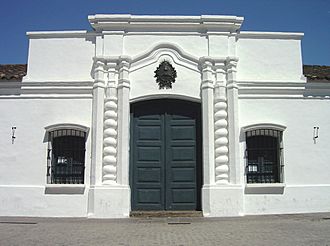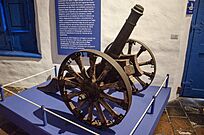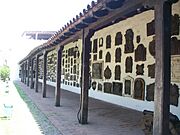Casa de Tucumán facts for kids
Quick facts for kids Historical House of Independence |
|
|---|---|
|
Casa histórica de la independencia
|
|

The Historical House of Tucumán, where the Argentine Declaration of Independence was signed.
|
|
| General information | |
| Town or city | San Miguel de Tucumán |
| Country | Argentina |
The Historical House of Tucumán (in Spanish, Casa Histórica de Tucumán) is a famous museum and historic building in San Miguel de Tucumán, Argentina. It was first built when Argentina was a Spanish colony. This house is very important because it's where the Argentine Declaration of Independence was signed on July 9, 1816.
Many years later, the house was in bad shape and was partly torn down. But because of its importance, the government took ownership of it. In 1941, it was named a National Historic Monument of Argentina. It was then carefully rebuilt to look like it did in 1816.
Contents
History of the House
Early Days and Construction
The city of San Miguel de Tucumán was moved to its current spot in 1685. Like many Spanish colonial cities, it was built around a main square, or plaza. The land where the House of Independence stands was originally owned by a man named Diego Bazán y Figueroa. The house itself was built around 1760 by his descendants, Francisca Bazán and Miguel Laguna.
A Place for Independence
The Argentine War of Independence started in 1810. In 1812, an important fight called the Battle of Tucumán happened near the city. At that time, the Laguna-Bazán family was not living in the house. Instead, it was used as a barracks for soldiers of the Army of the North.
In 1816, leaders from all over the country came together for a big meeting called the Congress of Tucumán. They needed a place to meet, so the government rented the house from the family. The Congress began its work on March 1, 1816. Their most famous act was signing the Argentine Declaration of Independence on July 9. The Congress kept meeting in the house until February 1817, when it moved to Buenos Aires.
Falling Apart and Being Saved
After the Congress left, the house was used for a printing press. The family eventually moved back in. However, the humid weather in Tucumán and the old building materials caused the house to weaken over time. The family didn't have enough money to make the needed repairs.
By 1869, the house was in very poor condition. That year, a photographer named Ángel Paganelli took the first known pictures of it. These photos later became very important for rebuilding the house.
The Argentine government realized the house was a national treasure. In 1874, President Nicolás Avellaneda, who was from Tucumán, made the house property of the nation. The government decided to save the main room where independence was declared, which was called the "Hall of the Oath." They tore down the other crumbling parts of the building and built a post office around the historic hall.
Rebuilding a National Treasure
Later, President Julio Argentino Roca ordered a special structure to be built around the Hall of the Oath to protect it from the weather. At the entrance, two large sculptures were added. They were made by the famous artist Lola Mora. One sculpture shows the signing of the Declaration of Independence, and the other shows the May Revolution, the event that started the war for independence.
In 1941, the house was officially declared a National Historic Monument. A project began to rebuild the entire house to look exactly as it did in 1816. Experts used the old photos from Paganelli, building plans from the 1870s, and the original foundations found underground. The rebuilt house opened on September 24, 1943.
On July 9, 1947, President Juan Domingo Perón visited the house to announce that Argentina had paid off all its foreign debt, calling it the country's "economic independence." In 1971, a protest group entered the house and painted slogans on the walls, but the building was quickly secured.
The House Today
Today, the House of Tucumán is a popular museum. Every year on July 9, San Miguel de Tucumán becomes the capital of Argentina for the day. The President of Argentina and other leaders visit the house to celebrate Independence Day.
Each evening, a sound and light show called Son et lumière tells the story of the Declaration of Independence. The show is a great way for visitors to experience this important moment in Argentine history.
Gallery
-
The Hall where the Argentine Declaration of Independence was signed
See also
 In Spanish: Casa de Tucumán para niños
In Spanish: Casa de Tucumán para niños













